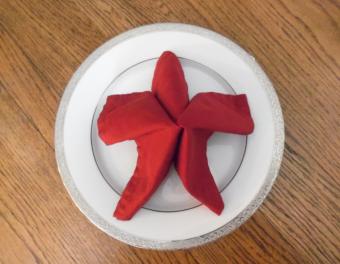
Turn a single square of origami paper into a star, a sealed square, and a box! Try these three unique paper folding projects to demonstrate the transformative nature of origami.
How to Fold a Four-Point Pinwheel Star
This star is a slight modification of the traditional origami pinwheel. It is best done with thin origami paper that has one patterned side and one white side. If you have a bone folder or a metal ruler, it can be helpful to use these tools to go over all of the creases so they are nice and sharp.
1. Start with the white side of your paper face up. Fold in half diagonally, creasing well. Unfold. Fold in half along the other diagonal, creasing well. Unfold to reveal an "X" shaped crease pattern.

2. Fold into thirds horizontally. Unfold. Fold into thirds vertically. Unfold. You should now have a crease pattern that looks like a tic-tac-toe board with an "X" going through it. Write a short message in the middle square, if desired.

3. Flip your paper over. Fold the bottom right corner up to meet the bottom corner of the first square in your crease grid. Crease well, then unfold.

4. Rotate the paper 90 degrees. Repeat the previous step. Continue folding the remaining two corners in this way. Open your paper so the entire square is flat on your work surface with the white side face up. Go over the valley folds at each corner of the paper to make the four sides start to rise up from the central square. (Valley folds are the folds that seem to sink down into the paper, while mountain folds are those that protrude up from the paper.)

5. Holding two opposite corners, start to twist the paper. As you continue the twist, the paper will collapse into a pinwheel shape. Gently press the creases flat to complete your four point star.

Making a Sealed Square Puzzle Purse
The square puzzle purse begins with the four-point pinwheel star that you made above.
1. Open the paper slightly and slip a hidden object inside, such as a flat chocolate coin. Start to close the square by folding the bottom point up.

2. Fold the left point over, fold the top point down, and then tuck the right point into the pocket created by the bottom point. This results in a closed square wrapping. In Victorian England, a similar design was used to exchange greetings on Valentine's Day.

Creating an Origami Magic Box
This "magic" box is simple to fold, but must be handled carefully. Take your time so that you don't tear the paper.
1. Open your square puzzle purse and remove the candy so you're back at the four-point pinwheel star position.
2. Inside reverse fold the bottom point of the star so it seems to disappear between the two layers of paper. An inside reverse fold is done by mountain folding the paper, prying it apart, and then pushing the tip down so it is in between the two sides of the paper. Origami Instructions explains the difference between inside reverse folds and outside reverse folds in greater detail if you're having trouble with this part of the project.

3. Repeat with the other three corners so you have a layered square with all of the star points hidden.

4. Fold each tip back and tuck it into the corresponding pocket. This can be a tight squeeze, so work slowly and carefully. You want to avoid wrinkling or tearing the paper when you tuck the tips into the pocket. The photo below shows one of the tips being tucked into the pocket. When you have all of the tips in the correct pockets, you'll have a square that looks much like the photo for the previous step, only with one less layer.

5. Your magic box is now complete. Carefully pull up on two opposite corners to pop open the box. Your origami magic box can be used to hold very lightweight items, but it is quite fragile and thus should not be used with anything that could tear or otherwise damage the paper.

Become an Origami Expert
To practice these simple origami projects, completely unfold the paper and see if you can use the creases to recreate each of them in succession. This exercise is an entertaining way to help improve your folding skills, which also makes it a fun project for an origami class with intermediate level students.







